Written by GRACE WILSON
Photography by PETER COLIN MURRAY
A WILD SWIM MOVEMENT resurfaced during the summer of 2020. Swimmers across the country found indoor pools closed, but the streams and rivers, lakes and seas wide open, and free. Once they got in open water, they found much more than just a spot to exercise — they found escape, healing waters and a new level of restoration.
During this time, my husband and I were also exploring all our new home in Savannah had to offer. As avid swimmers, we dreamed of swimming free in open waters without the interruption of pool walls. But we had lots of questions. Where could we access open water? Is river water clean and healthy? Are coastal waterways safe for swimming?
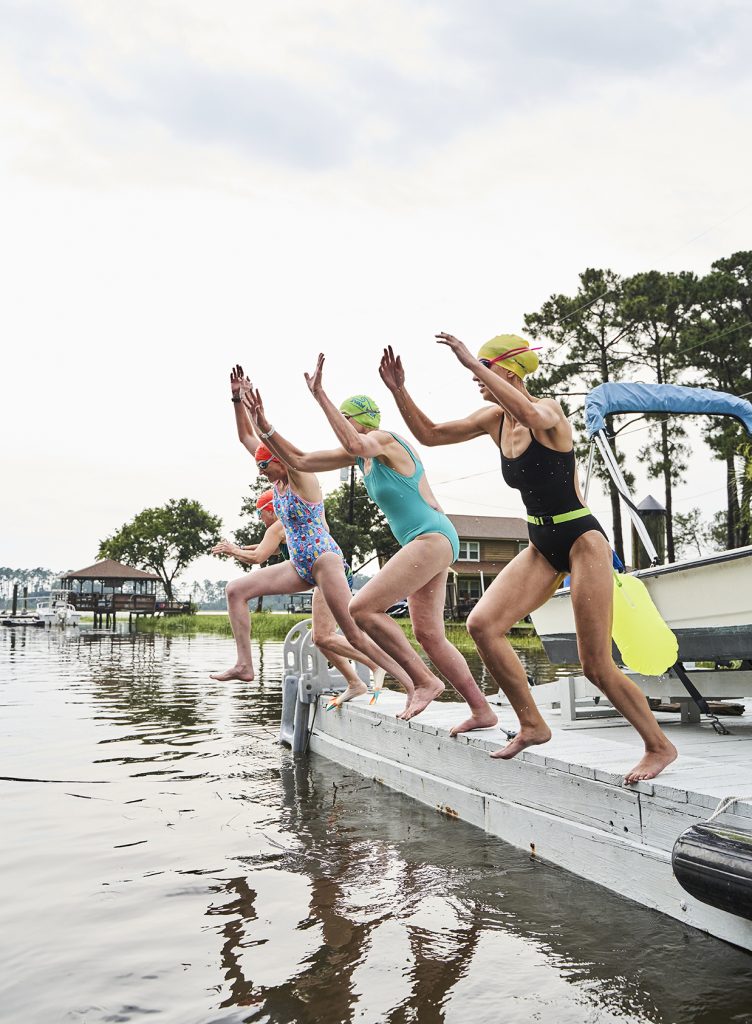
Research revealed a Facebook page for the Savannah Triathlon Team. Even though I’m hesitant on a bike and intimidated by Ironmen, I reached out to learn how they train for open water swims in Savannah’s rivers. What I found was less training and sport, and more return to the root of swimming and recreating in nature.
The Savannah Triathlon Team was largely started by John Jensen, a retired professor of ceramics and sculpture, who found escape in Savannah’s river many years before the trendy wild swim movement. He has been swimming in the Skidaway River for decades and innately understands the flow, the currents inside the creeks and the mood swings of the tide. The river is a place the artist can recharge his creative juices — not by dreaming up unique sculptures as he swims, but by letting his mind rest while his body falls into a meditative rhythm.
“The gift of being able to swim and commune with nature is free, and it’s what we need more and more of every day,” Jensen says.
I have discovered many of our coastal waterways are clean and safe for swimming, but there is more work to be done to make swimming in our waters accessible for all. The more I swim, and experience numerous benefits to my wellbeing, the more I seek to preserve the wild waters in our own back yards.
— Grace Wilson
He prefers to paddle across the water like a sleek kayak as he strokes by the reeds. Using a posture that places him on top of the water, he’s further lifted by the buoyancy of the salinity in the coastal river. This combination of fine-tuned posture and float sends him skating across the surface with every strong pull.
This method has taken Jensen far, and quite quickly too. With the current at his back, he’s sailed 10 kilometers down the Skidaway River from Modena Island, curving around Isle of Hope and landing on Butterbean Beach, a sliver of a beach off Rodney J. Hall Boat Ramp. He once extended this annual swim with a launch from Landing’s Harbor, which clocked in at over 10 miles.
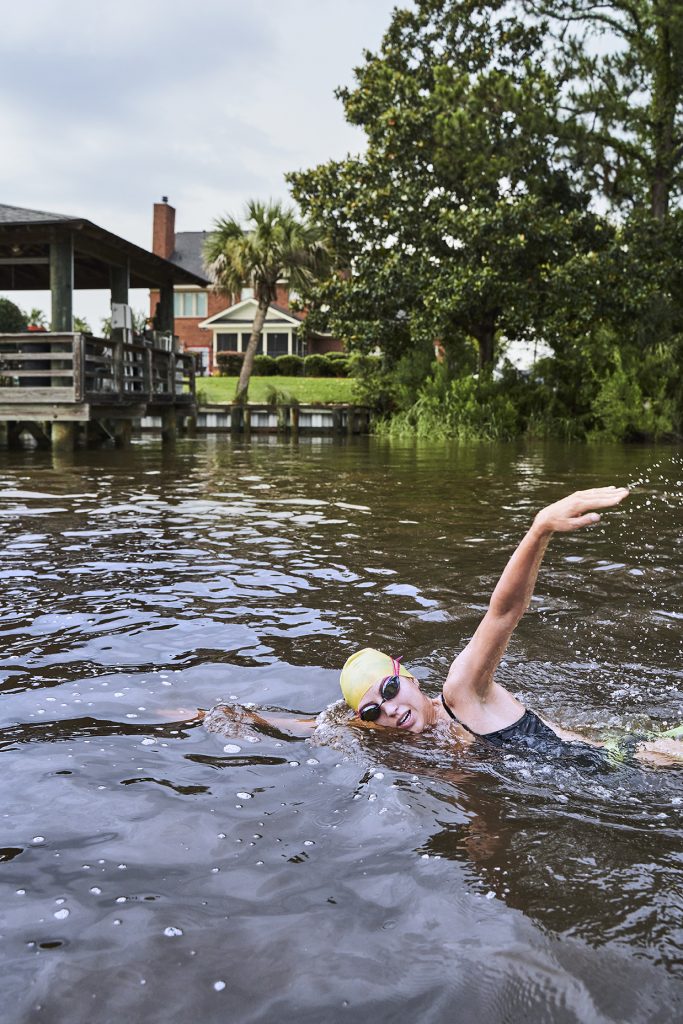
Jensen’s tales of freedom and escape found in the river attracted fellow flow seekers. In 1997, the nonprofit Savannah Triathlon Team was formed for athletes of all abilities and motivations to connect for group rides, runs and swims. With insurance and liability waivers in place, they were ready to invite the rest of Savannah to their training playground.
Today the group hosts organized swims in the Moon River every other Tuesday evening from late spring until the sun starts setting behind the western treeline in the fall. Some swimmers do train for triathlons and use the weekly swims to both build endurance and test the shoulder mobility of their wetsuits. However, most swimmers enjoy the feel of the river’s flow and the rebellion of submerging in seemingly forbidden dark water.

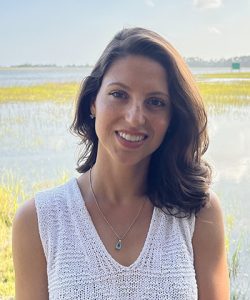
My first open water swim with Savannah Triathlon Team started at 6 o’clock on an average Tuesday night. The team marched down the aluminum ramp to our friend’s floating dock. I joined the swimmers and strapped a neon float around my waist. Other team members served as escort paddlers and clomped down the ramp with a kayak or paddleboard hoisted against their hip.
Jumping into the river for the first time took courage. I threw myself off the dock before I could second guess my actions, submerged and entered another world. However, I quickly popped back up thanks to buoyant salt water that lifted me higher than I had ever felt in the water. I looked back at the dock, only to find it a few feet further behind where I had lept. The current was already sending me forward. The swim had begun.
Once I got into the right body float and set my strokes into a rhythm, I found it was easy to lift my head and spot the neon floats tethered to each swimmer. Every few strokes, I lifted my eyes to sight the escort kayakers and paddlers who chart the best swimming course and keep watch for boaters on the horizon. I felt safety and solidarity when I fell into pace with a fellow swimmer by my side.
The moment I emerged from the water, my wild swim experience was all I would talk about. I couldn’t believe I could swim in nature and that the river was accessible for everyone to enjoy. Some couldn’t believe it either.
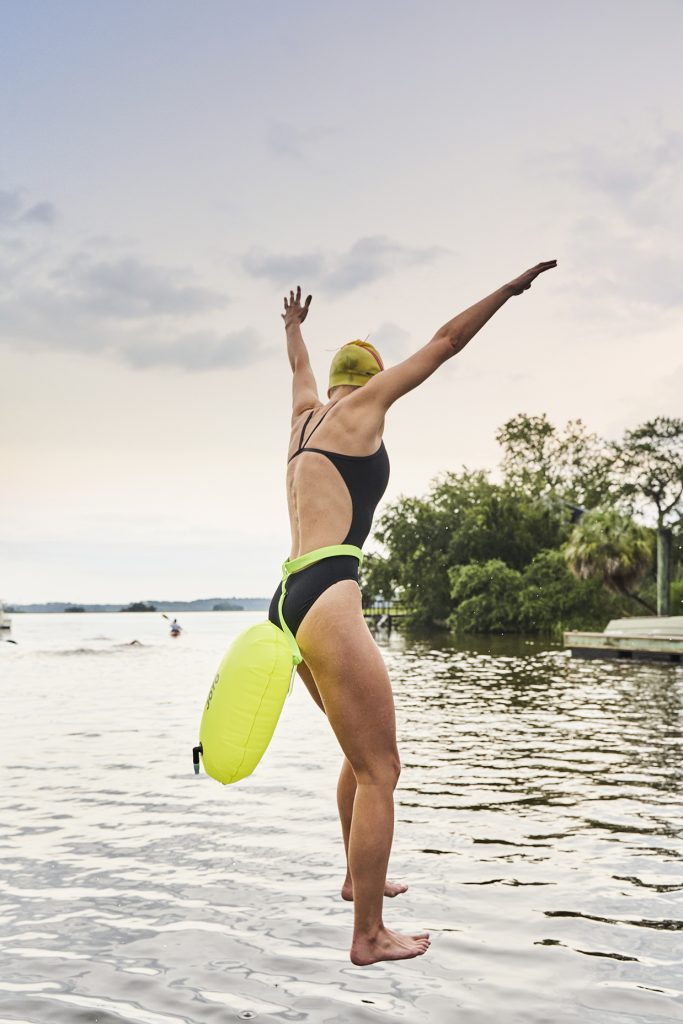
“Is it safe to swim in the river?” was usually the first reaction.“Is the water clean?”
These questions continued to float to the top of my mind as well, so I turned to local authorities who steward our waterways.
Savannah’s coastal rivers and waterways are monitored and protected by the Savannah Riverkeeper and the Ogeechee Riverkeeper. These nonprofits serve to protect and improve the water quality of the waterways in their river basins and showed me just how unique and complex the network of Savannah’s rivers is.
Georgia has the second largest amount of salt marshes in the United States. Fresh water flowing from the Ogeechee and the Savannah rivers is mixed with a flood of salt water from the Atlantic Ocean each tide cycle. Science tells us that every 12 hours, fingers of the rivers spent from draining are then flushed with salt water that weakens bacteria and dilutes any pollution from river runoff. The result is estuary waters with water quality that is remarkably healthy.
Since moving to Savannah, I’ve learned the best way to escape the summer heat is to head to the water. It may be thrilling to speed over the water in a boat or peaceful to skim across the surface in a kayak, but a true connection to the water is deepened if you are brave enough to jump in.
— Grace Wilson
The water may be dark, but that doesn’t mean it’s dirty. The color of the river comes from sediment, some from the marsh reeds and some from blackwater rivers filled with tannins from tree bark and leaves. In some areas, the darker the water, the better — dark tannins have some natural properties that kill certain bacteria.
Both riverkeepers are dedicated to monitoring the quality of water along their respective waterways and routinely test the waters with a comprehensive panel that ranges from bacteria levels to dissolved oxygen. Together, they present water quality data on a publicly accessible and streamlined website called Know Your River. This site hosts a map lit with hundreds of blue dots for water access locations, such as boat ramps, and dozens of green dots where water quality tests give a green light for recreational use. Coastal waterways extending from the Ogeechee River and the Savannah River are highlighted in blue to show overall safety in designated use.
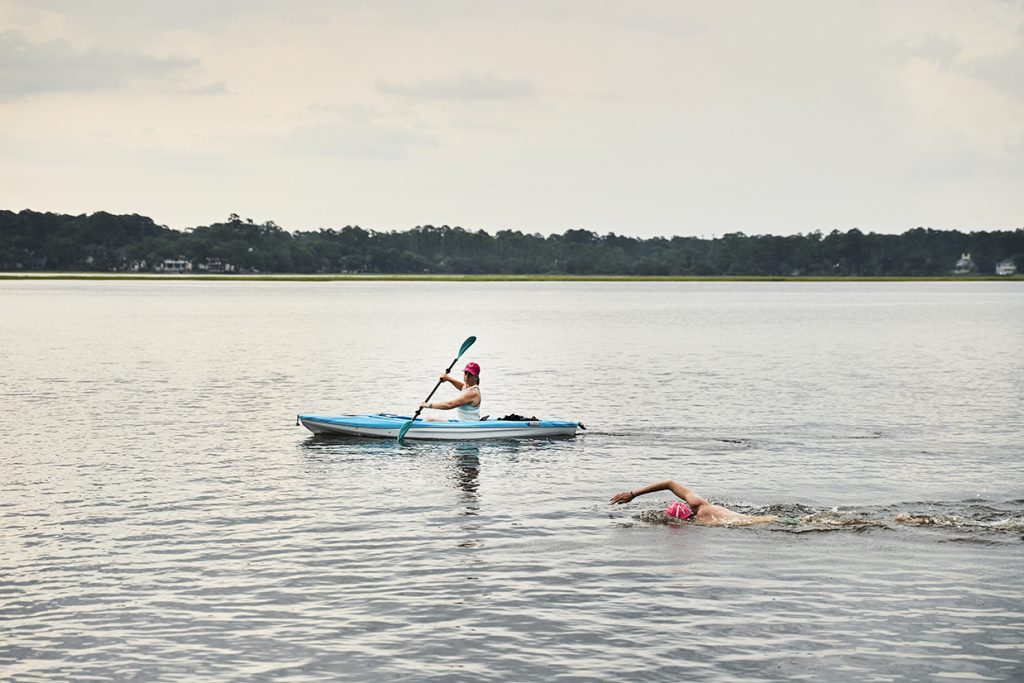
Damon Mullis, executive director of the Ogeechee Riverkeeper, and his team regularly test the water quality in the Ogeechee River watershed. The popular Butterbean Beach swimming spot along the Skidaway River has been coded blue, safe for swimming. However, other areas, such as the Vernon River which runs through south Savannah, show poor water quality due to stormwater run-off, litter and other sources of pollution.
“While many of the canals and small streams that feed into our coastal waters struggle with high levels of bacterial contamination, we rarely see levels in the larger water bodies that would prevent swimming,” says Mullis. “It’s our job to clean up these canals and small streams to protect these rivers for generations to come.”
These rivers are vital to life in Savannah. The Savannah River provides energy upstream, hosts the fourth busiest port in the nation at its mouth, and supplies drinking water to more than 1.5 million people. Local ecology also depends on our rivers — the Nature Conservancy estimates that the Savannah River basin is teeming with such a myriad wildlife, the diversity rivals that of a South American rainforest.
It’s natural to have a respectful fear for wildlife swimming in dark water, but most fish dart away from a threatening shadow splashing on the surface. Dorsal fins that peak above the surface usually belong to dolphins that tempt boats to race and invite swimmers to play with a squeak only audible underwater. Every local swimmer has their own tall “tail” to tell, but the general consensus is that higher levels of salt in coastal waterways deter alligators, and sharks stick closer to the feeding frenzies created by fishermen by the pier at Tybee Island.

On a typical Saturday afternoon, Butterbean Beach is packed. Over a dozen kayakers land in reeds and sea oxeye, close enough to the beach. A puddle jumper zips past with a bucket of sand. Off to the side, a fisherman casts in a shadow by the reeds. A dog bounds into the water after a ball. I put on my yellow cap to swim from piling to piling in the designated swim zone.
There’s a reason Butterbean Beach is popular. It is conveniently located at the Rodney J. Hall boat ramp, down the road from Pin Point and below the Diamond Causeway Bridge. The boat ramp has ample parking, a covered pavilion and a few picnic tables under the shade of cedar and live oak trees. The small bean-shaped beach still has enough sand to accommodate a zero-depth entry into the Skidaway River.
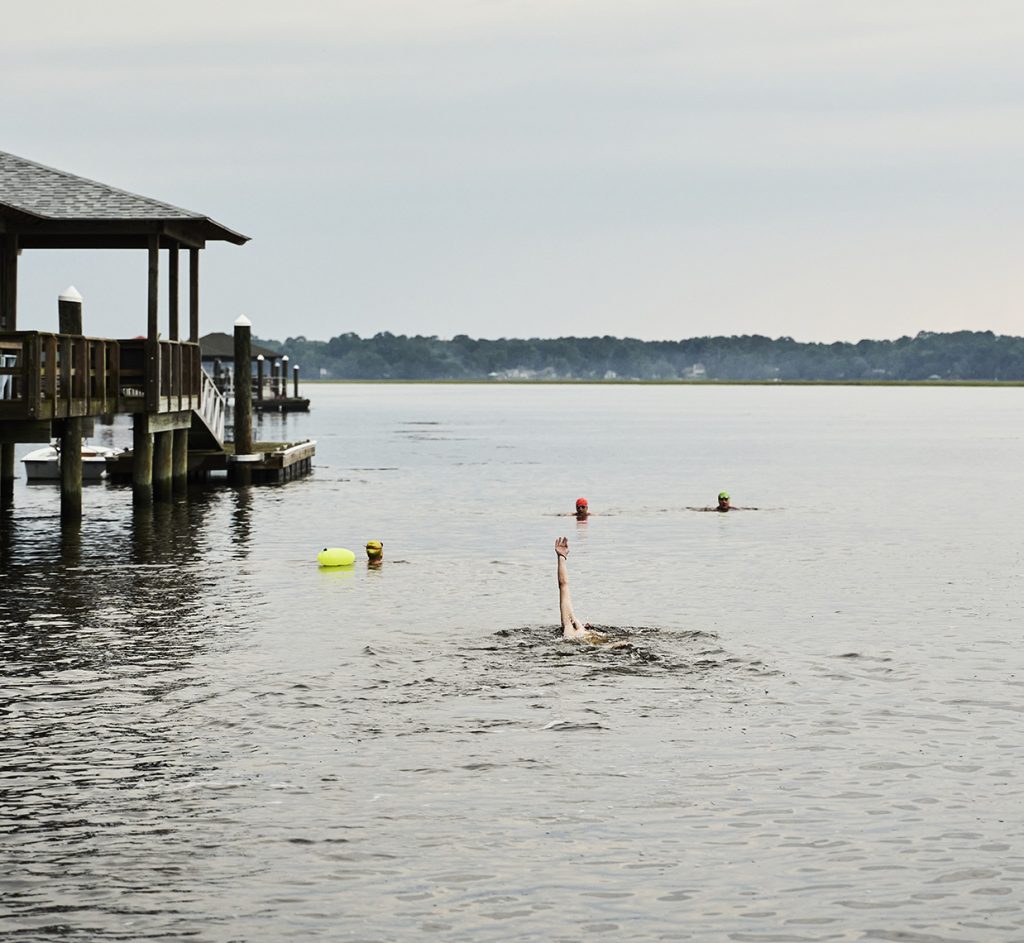
But Butterbean Beach is also popular because it is one of the few spots the public can access the river on foot. Savannah has many public boat ramps scattered along the coastal waterways, and each offers a varying level of accessibility for kayakers, paddlers and swimmers. In Chatham County, the Georgia Department of Natural Resources (DNR) monitors water quality regularly on the beaches of Tybee Island, and swim advisories can be found at CoastalGaDNR.org.
We have a right to recreate in our waters, boat or no boat. According to the DNR, all waters that are affected by the ebb and flow of the tide are considered to be in the Public Trust, meaning they are available for the public to use recreationally. Land access to the water may be private, but the flow of the water itself remains one of the last spaces that belongs to all. We need to share public access points and make these entry points safe for everyone to use. Without access for all, we limit our freedom to explore all the ways we can connect with the waters in our area.

The more I swam in the river, the better my body felt. I may emerge from a river swim with a bit of pluff mud, but it’s nothing compared to the way chlorine dries my skin and causes me to sneeze after every pool swim. My posture is lengthened and my muscles are stretched when I reach for the horizon with every stroke.
Simply breathing salt air benefits our lungs and wellbeing, but submerging in saltwater buoys these benefits even further. Various studies have linked the minerals in saltwater — magnesium, zinc, iron and potassium — to a range of positive outcomes, from reduced inflammation and healthier skin to reduced stress and better sleep to boosted moods and immune systems, among others.
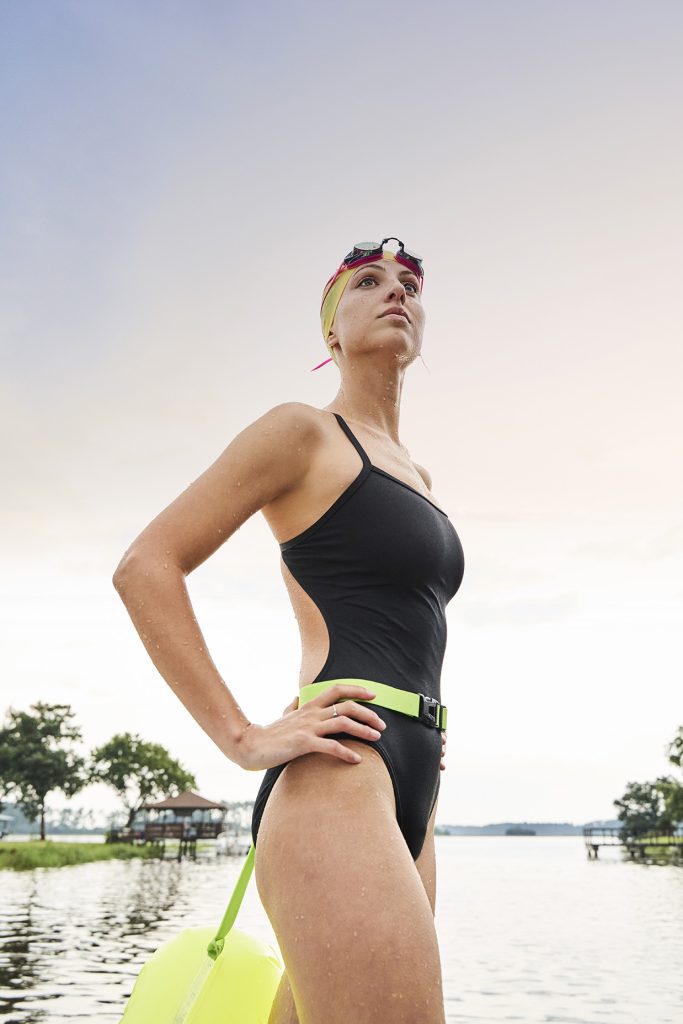
When we preserve our river, we preserve a sacred space that can offer total body restoration. By swimming in our wild waters, we can raise water quality standards. Swimmers won’t settle for polluted creeks and canals, waterways that squeak by safety requirements, and rivers dredged and distorted. The more we swim in our wild waters, the more we advocate for increasing public access to our waterways.
Perhaps the most impactful way we can show support for the preservation of our wild coastal waters is to team together and jump in. Along the way, we’ll preserve a bit of ourselves.
Grace Wilson is a writer and avid open water swimmer. Since moving to Savannah and swimming with the Savannah Triathlon Team, she has joined the Georgia River Network as the communications director, further helping to improve water quality and increase access to waterways statewide.

READY TO JUMP IN?
Safety first. Swim at your own risk and never swim solo. Have a paddler escort the safest route for swimming. Always obey signs at the beach or advisories from official government agencies.
Is the water clean? In addition to knowyourriver.org and CoastalGaDNR.org, you can monitor water quality at mywaterway.epa.gov.
Check the current. Check the tides to understand which direction the current is moving and how strong. The best time to swim is as the high tide falls. If you are swimming out and back, swim against the current to build endurance and then ride the tide on the return trip. Ask a fellow swimmer about tide timing and swim spots.
Watch the weather. Do not swim during the presence of thunder or for a day or two after heavy rain, as stormwater runoff may temporarily pollute certain waterways.
Join a swim group. The Savannah Triathlon Team conducts seasonal swims for annual members. Those interested in learning more about open water swims with Savannah Triathlon Team, can visit their runsignup.com page.
Advocate for public access. Georgia River Network has built water trails that list public access points across the state. Join their mission to increase access to swimming in coastal Georgia. For more info, visit garivers.org.




